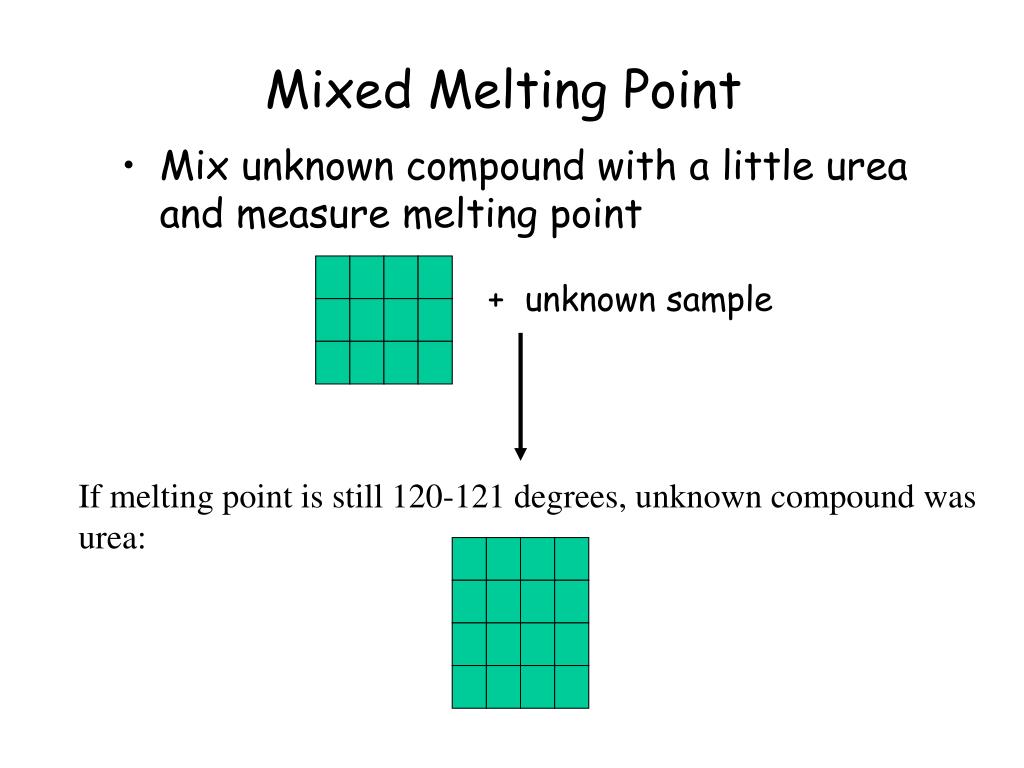

However, the presence of a foreign particle in a crystal lattice interrupts its uniform structure and the forces of attraction are weakened. A pure solid will generally melt sharply because the forces of attraction between its particles are the same. A solid is said to melt sharplyif the melting point range is 0.5 – 1.0 deg. Melting points recorded in the chemical journals are capillary melting points unless otherwise stated. A capillary melting point is defined as the temperature range over which a small amount of solid in a thin walled capillary tube first visibly softens (first drop of liquid) and then completely liquefies. Thus, in practice, most melting points are determined as capillary melting points, which can be done quickly with a small amount of sample. Ethyl alcohol, acetone, sugar and salt are impurities substance.A soluble impurity contributes to the total vapour pressure,therefore lowering the partial vapour pressure required of the pure substance in the melt and thus lowers the temperature necessary for melting.Addition of more impurity will produce corresponding lowering in the partial vapour pressure of the pure substance and hence ,lowering of the melting point.ĭISCUSSION Determination of the temperature at which the solid and liquid phases of a substance are in equilibrium is tedious and time consuming it is also quite difficult with a small amount of sample. There are four aparatus used to measure the melting points of organic substances.They are melting point bath,long-necked flask,thiele tube and electrically heated melting point. Then we will repeat the melting point determination of the known substance until good results are obtained.We will contaminate the known substance with a foreign substance.And then we will determine its melting point and observe the effect that contamination has on the sharpness of a melting point.Finally we will obtain an unknown substance and determine its melting point and we will record the results. PROCEDURE First we will select the a known substances and determine its melting point. Therefore, you can only measure the melting point of steel with a specific chemical composition.INTRODUCTION The purpose of experiment is melting point determinations of any substances and effect of the impurities on the melting point. In addition, steel manufacturers adjust the alloy ratio within the specified alloy content range according to their needs, and different batches of steel have slightly different metal element content. Even for the same steel grade, the melting temperature is not exact, taking the most commonly used 304 stainless steel (also known as 18/8 stainless steel, containing 18-20% Cr and 8-10.5% Ni) as an example, the melting temperature range is 2550-2790 ☏ (1400-1530 ☌), because the content of each alloying element is not a fixed value. In addition, there are hundreds of steel grades, and the chemical composition of different grades of steel varies. Unlike pure iron, steel has a variety of metallic elements, and each alloying element usually has a specified content range, which results in steel alloys with a wide melting temperature range. Why is the Melting Point of Steel a Range, Not an Exact Point?Īs mentioned at the beginning, the steel melting point mainly depends on the strength of the bonds between the atoms in the chemical composition (alloying element).Īll pure metals have stable melting points, for example, pure iron has a melting point of 2,800☏ (1,538☌) because it has only one metallic element – “Fe”. That is, steel will melt more easily and more rapidly when heated at higher pressures. As the external pressure increases, the melting temp of steel decreases. In addition, the melting temperature of steel is also affected by external pressure. The melting point of stainless steel and other alloy steels is mainly affected by alloying elements. The melting point of carbon steel depends on the carbon content, generally, the higher the carbon content in the steel, the lower its melting temperature. The stronger the bond strength between atoms, the higher the melting temperature.

The melting point of steel is 1300-1540☌ (2370-2800☏), depending primarily on the chemical composition of the steel, which can affect the strength of the bonds between atoms. Melting Point of Steel – Low (Mild), Medium & High Carbon Steel Melting Temperature (Temp)


 0 kommentar(er)
0 kommentar(er)
